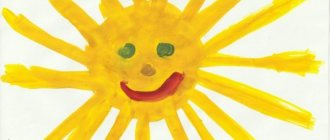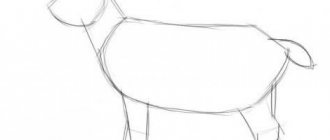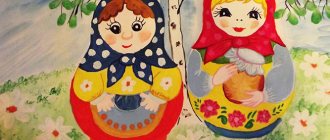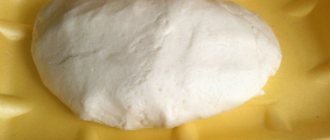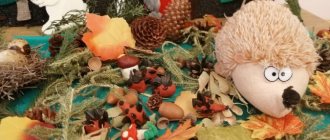Photo examples of ready-made Hedgehog figurines made of plasticine
The hedgehog from Smeshariki looks very impressive and “natural”, especially successful versions made from light plasticine. This is clearly visible on numerous
photos and pictures among the finished works. You can also make an “exotic” cactus from plasticine to accompany the Hedgehog figurine. All fans know that Hedgehog collects cacti and candy wrappers.
By creating with their own hands their favorite character - the Hedgehog from the cartoon Smeshariki from plasticine, children develop their imagination and thinking, and develop hand motor skills. The child will be proud of the finished craft and use it in his games. You can create other “cartoon” characters. These plasticine crafts will fit perfectly into the interior of a child’s room, they can be given to a friend, they are durable and compact when stored.
Step-by-step instructions with photos on how to make a Hedgehog from plasticine
To be more similar to the original, you need to select plasticine material in exactly the same shades. In our case, the Hedgehog from the cartoon Smeshariki should be made of raspberry plasticine. Needles and glasses should be purple. It is also necessary to remember that our hero’s character is serious and modest. The Hedgehog himself belongs (in the cartoon) to the “group” of children, unlike, for example, Sovunya or Pina - they are adults. These characteristics must be present in the character.
To make a hedgehog from smeshariki with your own hands, you should prepare your workplace in advance. Place a wooden or plastic board on the table, you will need a stack and plasticine - crimson, purple, a little white, red and black.
It is better for the smallest craftsmen to sculpt from airy plasticine - it is malleable and easier for children’s hands to work with. Let's look at how to mold a Hedgehog from plasticine step by step:
- The raspberry layer is divided into two parts - a ball is formed from the larger one, the other is left to create legs.
- They make limbs. An oval blank is formed, bent in half and the hind leg is sculpted, then the second one. For the front legs, two “droplets” are created.
- Spines are formed from purple plasticine in the form of small, even cones - there are 12 of them.
- The spines are placed on a round raspberry blank. First, 8 elements are laid out in a row and in a circle (in the form of a “sun with rays”), then the remaining 4 pieces. placed to fill the empty space. The result is a “needle hairstyle”.
- The front and rear legs are fixed to the body.
- Making a Hedgehog's face. A small piece of crimson plasticine is placed in the middle of the future “face” and the base is formed. Then a red plasticine triangle is molded into its center, imitating a nose.
- Other details are sculpted separately - the eyes are made of white, the pupils are made of black plasticine (in the form of flat circles), and the crimson ears are in the form of flattened balls.
- Thin “threads” are rolled out of purple plasticine (2 pieces long and 2 pieces short) - these are the elements for assembling glasses, the main attribute of the Hedgehog.
- A long purple “thread” is carefully wrapped around each eye, leaving a gap of a few mm at the left eye where the eyes meet. The blanks are connected.
- The eyes with glasses are attached above the nose, then short purple “threads” are fixed to them (towards the ears) - these are the spectacles. Then the ears are sculpted.
- The last nuance of the eyebrows is that they are molded from purple plasticine in the form of tiny ovals and placed above the eyes.
A smile is formed with a stack, making a vertical line from the nose down and a horizontal semicircle.
To make the Smeshariki hedgehog as identical as possible, the back is designed exactly like the original. To do this, a flat and round purple cake is formed. In the upper part, the excess is smoothly cut off with a stack, giving the shape of a drop. The workpiece is fixed on the back of the body, and needles are attached to it.
Video master classes and lessons on sculpting Smesharik Hedgehog
To make the creative process easy, first watch the video “lesson” and only after that, sculpt a Smesharik hedgehog from plasticine. In this case, the craft will turn out perfect on the first try.
Hedgehog made from coffee beans
A fragrant coffee hedgehog will bring a lot of pleasure during production. There is one more pleasant moment. All mothers eventually notice that children's crafts do not last long. But you won’t want to throw away such a fragrant animal.
It will bring positive emotions to the house:
- coffee aroma neutralizes unpleasant odors;
- creates a cozy atmosphere;
- According to legend, hedgehogs are good protectors of the family from gossip and attacks, so it will become an excellent amulet.
Craft materials:
- a small plastic ball;
- whole coffee beans;
- brown or black plasticine;
- hard cardboard;
- glue “Moment” or thermo-gun;
- eyes and nose (ready-made, buttons or beads);
- for the muzzle: apply glue to a piece of polystyrene foam in the shape of a cone and wind household threads (twine);
- for composition: whole cloves, 2 cinnamon sticks, star anise, dried rowan berries (choose to your taste).
Craft hedgehog made from chestnut and plasticine
Chestnut has a very interesting shell that can be used for crafts. Its shape resembles the spines of hedgehogs, so we will use it for the animal’s fur coat. The basis of the hedgehog will be the fruit itself - the nut. We sculpt an elongated sharp muzzle and glue it to the nut. We attach ready-made eyes on top, or we sculpt them ourselves. We sculpt a mouth from a small piece of red plasticine. Glue chestnut shells on top. You can create a composition from a hedgehog and dried autumn leaves.
What are the benefits of modeling?
Most parents know about the benefits of playing with plasticine. But why are they so useful?
Psychologists say that games develop:
- Fine motor skills. Statistics confirm that children who played with plasticine before the age of five are much less likely to turn to a speech therapist. This is due to the fact that in the cerebral cortex there is a fine motor center that actively interacts with speech. Accordingly, when a child sculpts, he automatically develops his speech center.
- Attentiveness. The baby will make from plasticine what you show him. And such a game will be very interesting to him. First you will sculpt small parts: circles, balls, etc. Then move on to more complex ones. Thus, the child himself will create the texture of the object, paying attention to all the details.
- Perseverance. It is very difficult to captivate a child aged two to five years with anything. The baby's interest lasts for a maximum of 10 minutes. But your imagination and proposal to fashion a new figure from plasticine immediately returns the child to the process. Therefore, such an activity has a positive effect on the formation of perseverance.
- Tactile sensitivity. The baby learns from his own feelings to create a variety of objects and their texture. He easily changes it with his fingers.
How to make a hedgehog from plasticine
If your child likes to create animal figures from plasticine, invite him to make a hedgehog. This cute, prickly animal will add to your baby's collection of products. To make a little animal, we suggest you choose one of the instructions below. You will learn how to make a hedgehog from plasticine in different ways.
If you have already sculpted a cat from plasticine, which we talked about in the previous article, then making a charming hedgehog will not be difficult. We have selected several options for making a hedgehog for you. The first two will be based only on the use of plasticine.
